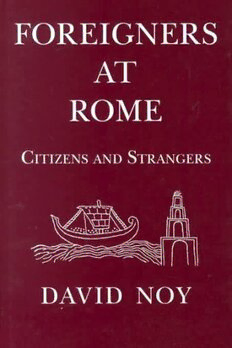
Foreigners at Rome: Citizens and Strangers PDF
Preview Foreigners at Rome: Citizens and Strangers
FOREIGNERS AT ROME FOREIGNERS AT ROME C S ITIZENS AND TRANGERS David Noy Duckworth with The Classical Press of Wales First published in 2000 by Gerald Duckworth & Co. Ltd. 61 Frith Street, London W1V 5TA Distributor in the United States of America: The David Brown Book Co. PO Box 511, Oakville, CT 06779 Tel: (860) 945–9329 Fax: (860) 945–9468 Originated and prepared for press at The Classical Press of Wales 15 Rosehill Terrace, Swansea SA1 6JN Tel: 01792 458397 Fax: 01792 419056 © 2000 All rights reserved. No part of this publication may be reproduced, stored in a retrieval system, or transmitted, in any form or by any means, electronic, mechanical, photocopying, recording or otherwise, without the prior permission of the publisher. ISBN 0 7156 29522 A catalogue record for this book is available from the British Library Typeset by Ernest Buckley, Clunton, Shropshire Printed and bound in the UK by Antony Rowe Ltd., Chippenham, Wiltshire To the memory of Jean Norris Midgley 1914–1996 CONTENTS Page Introduction ix Section I. Evidence and ancient attitudes 1. The evidence and the problems 1 i. Latin terminology 1 ii. Temporary and permanent residence at Rome 3 iii. Status 4 iv. The limitations of the evidence 4 v. Integration and separation 10 2. The demographic and legal background 15 i. The size of Rome’s whole population 15 ii. Natural demographic decrease 18 iii. The military population 19 iv. Fluctuations in immigration 22 v. Citizenship among foreigners at Rome 23 3. Attitudes to foreigners 31 i. Positive statements about the presence of foreigners at Rome 31 ii. Neutral statements 33 iii. Negative statements 34 iv. Foreign slaves 37 v. Expulsions of foreigners from Rome 37 vi. Expulsions of specific groups 41 vii. Encouragement of immigration 47 Section II. Moving to Rome 4. Who moved to Rome? 53 i. Patterns of migration 53 ii. Socio-economic background of migrants 56 iii. Where did immigrants come from? 57 iv. The gender of immigrants 60 v. The ages of immigrants 63 vi. The immigration of individuals and family groups 67 vii. Legal status of immigrants 75 5. Why did people move to Rome? 85 i. Evidence 85 vii ii. Push and pull factors 86 iii. Types of motivation suggested by Seneca 90 iv. Education 91 v. Government and politics 97 vi. Provision of goods and services 110 vii. Family and religion 123 6. The practicalities of moving to Rome 141 i. How to get to Rome 141 ii. First impressions of Rome 144 iii. Where to go when you reached Rome 146 iv. Where to stay 149 v. Finding work 150 vi. Location of housing 151 Section III. Living at Rome 7. Aspects of foreigners’ lives at Rome 157 i. Group identity – and lack of it 157 ii. Stationes 160 iii. Contact with the homeland 164 iv. Homesickness 167 v. Language 169 vi. Names 179 vii. Cults 183 viii. Burial practices 187 8. Foreign groups at Rome 205 i. Gaul and Hispania 205 ii. Central and Eastern Europe 212 iii. Greece 223 iv. Asia Minor 227 v. Syria 234 vi. Egypt 245 vii. North Africa 251 viii. Jews 255 Conclusion 285 Appendix: A list of individual immigrants recorded in 289 inscriptions Glossary 329 Abbreviations 331 Bibliography 333 Index 351 viii INTRODUCTION Leaving behind Nicaea in Bithynia while I was still a youth, I went to the glorious city and the land of the Ausonians. In hallowed Rome I taught accounts and measures. I, Basileus, obtained the tomb, the work of my mind. IGUR 1176 In the second year of the dictatorship of C. Caesar, with M. Antonius as magister equitum [47 BCE], the site of the tomb was bought from Q. Modius L.f. Qui. 24 feet wide, 24 feet deep. C. Numitorius C.l. Nicanor, by birth a Theban, eye doctor. Numitoria C.l. Philumina, by birth a Phrygian. C. Numitorius C.l. Stabilio, by birth a native slave. P. Opitreius C.l. Butas, by birth a Smyrnan. They built the foundation. In their tomb is buried: Numitoria C.l. Erotis, by birth a Carthaginian. Q. Numitorius C.l. Isio is buried there. AE (1972) 14 Papiria Rhome made this (monument) for herself while alive, and for Papiria Cladilla aged 19, and for P. Papirius Proculus aged 13(?), her children. Here the wretched(?) mother held two funerals, and she buried their bones with rites which are not just. For at Rome a falling roof-tile carried off Proculus. The deceased Cladilla lay on her funeral pyre at Sipontum. Your parental wishes did you harm. The cruel gods gave more good things so they could take more away. Also for P. Papirius Cladus her husband and for P. Papirius Celerio and Papiria Hispanilla her ex-slaves. CIL iii 2083 (Salona) Flavia Valeria placed this inscription for her well-deserving daughter Flavia Viventia, who lived 18 years. She had her burial on 31st July. This girl came from the province of Pannonia. She (lived) with her husband one year 8 months. In peace. ICUR 13155 Be of good cheer Serenus, child, untimely dead, aged 4 years 8 months 19 days. Fuscinus the emperor’s provocator his father and Taon his mother, Egyptians, made this (tomb), being left behind. IGUR 939 = ICUR 4032 ix
